实数编码的遗传算法代码
- 格式:docx
- 大小:15.90 KB
- 文档页数:2
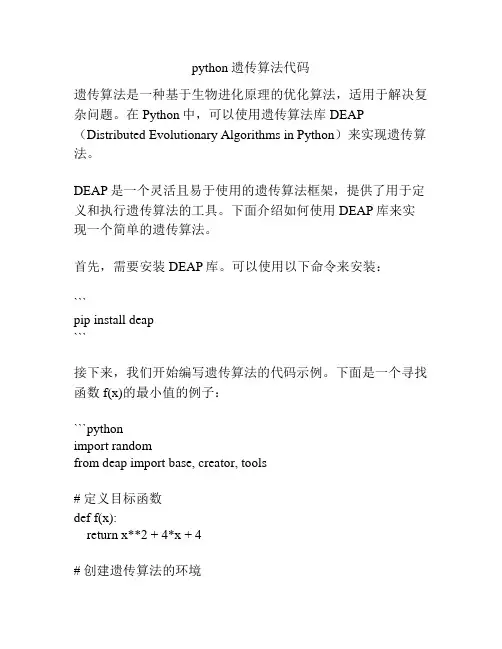
python遗传算法代码遗传算法是一种基于生物进化原理的优化算法,适用于解决复杂问题。
在Python中,可以使用遗传算法库DEAP (Distributed Evolutionary Algorithms in Python)来实现遗传算法。
DEAP是一个灵活且易于使用的遗传算法框架,提供了用于定义和执行遗传算法的工具。
下面介绍如何使用DEAP库来实现一个简单的遗传算法。
首先,需要安装DEAP库。
可以使用以下命令来安装:```pip install deap```接下来,我们开始编写遗传算法的代码示例。
下面是一个寻找函数f(x)的最小值的例子:```pythonimport randomfrom deap import base, creator, tools# 定义目标函数def f(x):return x**2 + 4*x + 4# 创建遗传算法的环境creator.create("FitnessMin", base.Fitness, weights=(-1.0,)) creator.create("Individual", list, fitness=creator.FitnessMin)# 初始化遗传算法的参数toolbox = base.Toolbox()toolbox.register("attr_float", random.uniform, -10, 10) toolbox.register("individual", tools.initRepeat, creator.Individual, toolbox.attr_float, n=1)toolbox.register("population", tools.initRepeat, list,toolbox.individual)# 定义评估函数def evaluate(individual):x = individual[0]return f(x),# 定义遗传算法的操作toolbox.register("evaluate", evaluate)toolbox.register("select", tools.selTournament, tournsize=3) toolbox.register("mate", tools.cxTwoPoint)toolbox.register("mutate", tools.mutGaussian, mu=0, sigma=1, indpb=0.1)# 设置遗传算法的参数population_size = 100n_generations = 100cxpb = 0.5mutpb = 0.2# 创建初始种群population = toolbox.population(n=population_size)# 进化for generation in range(n_generations):offspring = toolbox.select(population, len(population))offspring = [toolbox.clone(ind) for ind in offspring]for child1, child2 in zip(offspring[::2], offspring[1::2]):if random.random() < cxpb:toolbox.mate(child1, child2)del child1.fitness.valuesdel child2.fitness.valuesfor mutant in offspring:if random.random() < mutpb:toolbox.mutate(mutant)del mutant.fitness.valuesinvalid_ind = [ind for ind in offspring if not ind.fitness.valid] fitnesses = toolbox.map(toolbox.evaluate, invalid_ind)for ind, fit in zip(invalid_ind, fitnesses):ind.fitness.values = fitpopulation[:] = offspring# 输出最优解best_individual = tools.selBest(population, k=1)[0]best_fitness = evaluate(best_individual)[0]print("Best individual:", best_individual)print("Best fitness:", best_fitness)```在上面的代码中,首先定义了目标函数f(x),然后创建了遗传算法的环境,包括创建适应度函数和个体类,以及注册遗传算法的操作。
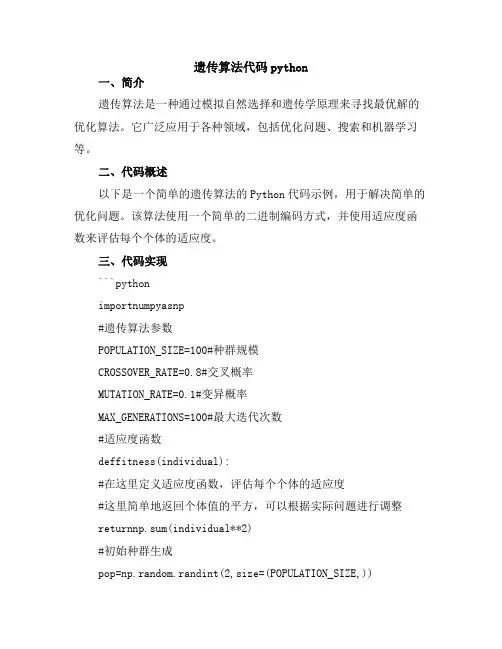
遗传算法代码python一、简介遗传算法是一种通过模拟自然选择和遗传学原理来寻找最优解的优化算法。
它广泛应用于各种领域,包括优化问题、搜索和机器学习等。
二、代码概述以下是一个简单的遗传算法的Python代码示例,用于解决简单的优化问题。
该算法使用一个简单的二进制编码方式,并使用适应度函数来评估每个个体的适应度。
三、代码实现```pythonimportnumpyasnp#遗传算法参数POPULATION_SIZE=100#种群规模CROSSOVER_RATE=0.8#交叉概率MUTATION_RATE=0.1#变异概率MAX_GENERATIONS=100#最大迭代次数#适应度函数deffitness(individual):#在这里定义适应度函数,评估每个个体的适应度#这里简单地返回个体值的平方,可以根据实际问题进行调整returnnp.sum(individual**2)#初始种群生成pop=np.random.randint(2,size=(POPULATION_SIZE,))#迭代过程forgenerationinrange(MAX_GENERATIONS):#评估种群中每个个体的适应度fitness_values=np.apply_along_axis(fitness,1,pop)#选择种群selected_idx=np.random.choice(np.arange(POPULATION_SIZE), size=POPULATION_SIZE,replace=True,p=fitness_values/fitness_va lues.sum())selected_pop=pop[selected_idx]#交叉操作ifCROSSOVER_RATE>np.random.rand():cross_points=np.random.rand(POPULATION_SIZE,2)<0.5#随机选择交叉点cross_pop=np.array([np.hstack((individual[cross_points[i, 0]:cross_points[i,1]]+individual[cross_points[i,1]:],other))f ori,otherinenumerate(selected_pop)]).T#合并个体并随机交叉得到新的个体cross_pop=cross_pop[cross_points]#将交叉后的个体重新排列成原始种群大小selected_pop=np.vstack((selected_pop,cross_pop))#将新个体加入种群中#变异操作ifMUTATION_RATE>np.random.rand():mutated_pop=selected_pop+np.random.randn(POPULATION_SIZE, 1)*np.sqrt(np.log(POPULATION_SIZE))*(selected_pop!=pop).astyp e(np.float)#根据变异概率对个体进行变异操作,得到新的个体种群mutated_pop=mutated_pop[mutated_pop!=0]#将二进制种群中值为0的个体去掉,因为这些个体是随机的二进制串,不是解的一部分,不应该参与变异操作selected_pop=mutated_pop[:POPULATION_SIZE]#将新种群中除最后一个以外的部分加入原始种群中(即新的种群被排除了适应度最差的个体)#选择当前最好的个体(用于更新最优解)best_idx=np.argmax(fitness_values)best_solution=selected_pop[best_idx]print(f"Generation{generation}:Bestsolution:{best_solutio n}")```四、使用示例假设要解决一个简单的优化问题:求一个一维函数的最小值。
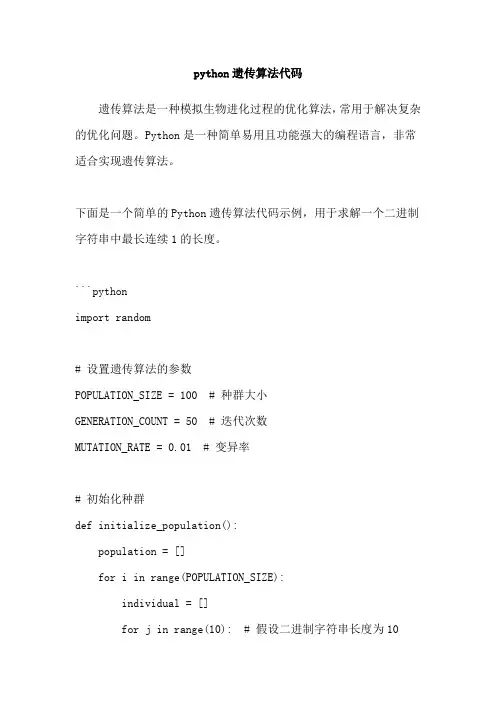
python遗传算法代码遗传算法是一种模拟生物进化过程的优化算法,常用于解决复杂的优化问题。
Python是一种简单易用且功能强大的编程语言,非常适合实现遗传算法。
下面是一个简单的Python遗传算法代码示例,用于求解一个二进制字符串中最长连续1的长度。
```pythonimport random# 设置遗传算法的参数POPULATION_SIZE = 100 # 种群大小GENERATION_COUNT = 50 # 迭代次数MUTATION_RATE = 0.01 # 变异率# 初始化种群def initialize_population():population = []for i in range(POPULATION_SIZE):individual = []for j in range(10): # 假设二进制字符串长度为10gene = random.randint(0, 1)individual.append(gene)population.append(individual)return population# 计算适应度def calculate_fitness(individual):fitness = 0current_streak = 0for gene in individual:if gene == 1:current_streak += 1fitness = max(fitness, current_streak)else:current_streak = 0return fitness# 选择操作:轮盘赌选择def selection(population):total_fitness = sum([calculate_fitness(individual) for individual in population])probabilities = [calculate_fitness(individual) /total_fitness for individual in population]selected_population = []for _ in range(POPULATION_SIZE):selected_individual = random.choices(population, weights=probabilities)[0]selected_population.append(selected_individual)return selected_population# 交叉操作:单点交叉def crossover(parent1, parent2):point = random.randint(1, len(parent1) - 1)child1 = parent1[:point] + parent2[point:]child2 = parent2[:point] + parent1[point:]return child1, child2# 变异操作def mutation(individual):for i in range(len(individual)):if random.random() < MUTATION_RATE:individual[i] = 1 - individual[i] # 变异位点翻转return individual# 主函数def genetic_algorithm():population = initialize_population()for _ in range(GENERATION_COUNT):population = selection(population)# 交叉操作new_population = []for i in range(0, POPULATION_SIZE, 2):parent1 = population[i]parent2 = population[i + 1]child1, child2 = crossover(parent1, parent2)new_population.append(child1)new_population.append(child2)# 变异操作population = [mutation(individual) for individual in new_population]best_individual = max(population, key=calculate_fitness) return best_individual# 运行遗传算法best_individual = genetic_algorithm()best_fitness = calculate_fitness(best_individual)print('Best individual:', best_individual)print('Best fitness:', best_fitness)```该代码首先初始化一个种群,然后通过选择、交叉和变异操作迭代地更新种群,并最终返回适应度最高的个体。
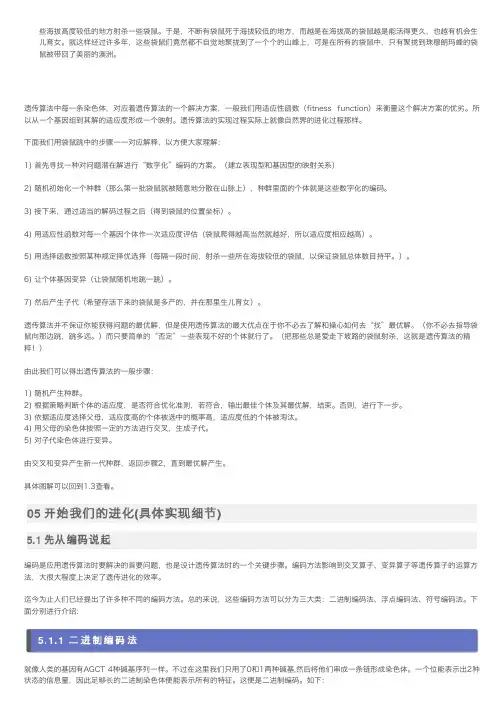

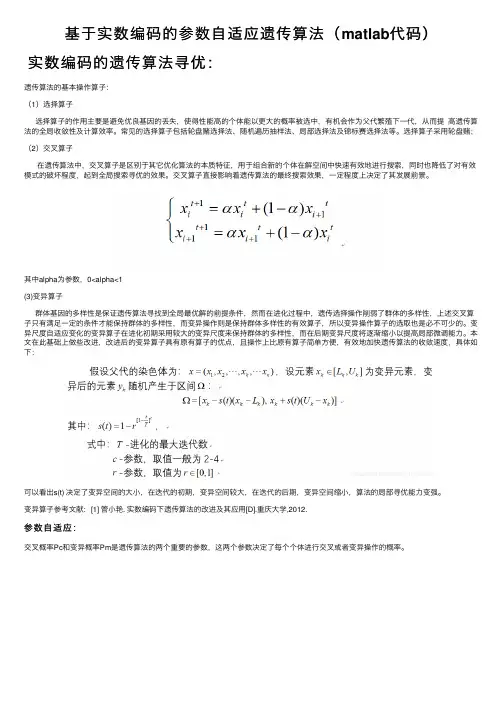
基于实数编码的参数⾃适应遗传算法(matlab代码)实数编码的遗传算法寻优:遗传算法的基本操作算⼦:(1)选择算⼦选择算⼦的作⽤主要是避免优良基因的丢失,使得性能⾼的个体能以更⼤的概率被选中,有机会作为⽗代繁殖下⼀代,从⽽提⾼遗传算法的全局收敛性及计算效率。
常见的选择算⼦包括轮盘赌选择法、随机遍历抽样法、局部选择法及锦标赛选择法等。
选择算⼦采⽤轮盘赌;(2)交叉算⼦在遗传算法中,交叉算⼦是区别于其它优化算法的本质特征,⽤于组合新的个体在解空间中快速有效地进⾏搜索,同时也降低了对有效模式的破坏程度,起到全局搜索寻优的效果。
交叉算⼦直接影响着遗传算法的最终搜索效果,⼀定程度上决定了其发展前景。
其中alpha为参数,0<alpha<1(3)变异算⼦群体基因的多样性是保证遗传算法寻找到全局最优解的前提条件,然⽽在进化过程中,遗传选择操作削弱了群体的多样性,上述交叉算⼦只有满⾜⼀定的条件才能保持群体的多样性,⽽变异操作则是保持群体多样性的有效算⼦,所以变异操作算⼦的选取也是必不可少的。
变异尺度⾃适应变化的变异算⼦在进化初期采⽤较⼤的变异尺度来保持群体的多样性,⽽在后期变异尺度将逐渐缩⼩以提⾼局部微调能⼒。
本⽂在此基础上做些改进,改进后的变异算⼦具有原有算⼦的优点,且操作上⽐原有算⼦简单⽅便,有效地加快遗传算法的收敛速度,具体如下:可以看出s(t) 决定了变异空间的⼤⼩,在迭代的初期,变异空间较⼤,在迭代的后期,变异空间缩⼩,算法的局部寻优能⼒变强。
变异算⼦参考⽂献: [1] 管⼩艳. 实数编码下遗传算法的改进及其应⽤[D].重庆⼤学,2012.参数⾃适应:交叉概率Pc和变异概率Pm是遗传算法的两个重要的参数,这两个参数决定了每个个体进⾏交叉或者变异操作的概率。
⾃适应算⼦参考⽂献:[2] M. Srinivas and L. M. Patnaik, "Adaptive probabilities of crossover and mutation in genetic algorithms," in IEEE Transactions on Systems, Man, and Cybernetics, vol. 24, no. 4, pp. 656-667, April 1994.doi: 10.1109/21.286385上述部分翻译⾃⽂献[2]按照论⽂描述,对算法的复现如下:% 测试函数图像% 测试函数图像% 改进的⾃适应遗传算法:% 参考⽂献:[7] M. Srinivas and L. M. Patnaik, "Adaptive probabilities of crossover and mutation in genetic algorithms,"% in IEEE Transactions on Systems, Man, and Cybernetics, vol. 24, no. 4, pp. 656-667, April 1994.% doi: 10.1109/21.286385clc;clear all;mode = 'Schaffer';% mode = 'self_define';if strcmp(mode, 'Schaffer')figure(1)x = -4:0.1:4;y = -4:0.1:4;[X,Y] = meshgrid(x,y);% Z = 3*cos(X.*Y)+X+Y.^2;Z = 0.5-((sin(sqrt(X.^2+Y.^2)).^2)-0.5)./(1+0.001.*(X.^2+Y.^2)).^2; surf(X,Y,Z);title('Schaffer Function');xlabel('X-轴');ylabel('Y-轴');zlabel('Z-轴');figure(2);contour(X, Y, Z, 8);title('Schaffer函数等⾼线');xlabel('X-轴');ylabel('Y-轴');endif strcmp(mode, 'self_define')figure(1);x = -4:0.1:4;y = -4:0.1:4;[X,Y] = meshgrid(x,y);% Z = 100.*(Y-X.^2).^2+(1-X).^2;Z = (cos(X.^2+Y.^2)-0.1)./(1+0.3*(X.^2+Y.^2).^2)+3;surf(X,Y,Z);%title('Rosen Brock valley Function');title('Self define Function');xlabel('X-轴');ylabel('Y-轴');zlabel('Z-轴');endclc;clearvars -except mode;r = 0.2;b = 3;NP=400;% Pc=0.65; % 将Pc,Pm参数改进为⾃适应参数% Pm=0.20;G=520; % 记得改D=2; % 变量个数k1 = 1;k3 = 1;k2 = 0.5;k4 = 0.5;X_min=-4;X_max=4;Y_min=-4;Y_max=4;% optimization_trace = []; % 三维数组, ⾏,列,叶for count_1=1:NP % 产⽣初始解temp1 = X_min+rand()*(X_max-X_min);temp2 = Y_min+rand()*(Y_max-Y_min);x(count_1,:) = [temp1,temp2];endsave_pic_cnt = 1;A = figure(3);for gen=1:G%pause(0.2);if rem(gen, 100)==1scatter(x(:,1), x(:, 2));axis([-4, 4, -4, 4]);title(['第', num2str(gen), '次迭代']);xlabel('变量X');ylabel('变量Y');base_path = 'C:\Users\18811\Desktop\graph\';cnt = num2str(save_pic_cnt);tail_path = '.jpg';frame = getframe(A);im=frame2im(frame);path_img = [base_path, cnt, tail_path];% imwrite(im, path_img);% save_x(:, :, save_pic_cnt) = x;save_pic_cnt = save_pic_cnt + 1;% scatter(0, 0, 'o', 'r');for count_2=1:NPfitness(count_2)=func(x(count_2,:), mode);end%[fitness_min,index0] = min(fitness);%fitness_max = max(fitness);[fitness_max,index0] = max(fitness);fitness_average = sum(fitness)/(length(fitness)); % 种群的平均值collect_fit_average(gen) = fitness_average; % 保存适应度的平均值collect_fitmax_subtract_fit_average(gen) = fitness_max - fitness_average; % 保存f_max-f_average ;fitness_min = min(fitness);best_indiv = x(index0,:); % 最优的个体% optimization_trace(gen,: , global_count) = best_indiv;% best_solution(gen) = fitness_min;best_solution(gen) = fitness_max;% 计算归⼀化的适应度值fitness = (fitness - fitness_min)/(fitness_max - fitness_min);fitness_sum = sum(fitness);fitness = fitness./fitness_sum;fitness = cumsum(fitness);% 选择算⼦:ms = sort(rand(NP,1));fiti = 1;newi = 1;while newi<=NPif ms(newi)<fitness(fiti)clone_x(newi,:) = x(newi,:);newi = newi + 1;elsefiti = fiti + 1;endendclone_x = clone_x(1:NP, :);% 进⾏交叉,变异操作% count=0;for count=1:2:NP% ⾃适应计算Pc.% 选区两个交叉的个体的较⼤的适应度值if fitness(count)>=fitness(count+1)fitness_selected = fitness(count);elsefitness_selected = fitness(count+1);end% 计算Pcif fitness_selected >= fitness_averagePc = k1*(fitness_max-fitness_selected)/(fitness_max-fitness_average);elsePc = k3;endcollect_Pc(gen, count) = Pc; % 保存Pc的值temp_cross = rand();if temp_cross < Pc% 交叉算⼦注:这种交叉算⼦效果更好temp_alpha = 0.6;cross_x(count,:) = temp_alpha*clone_x(count,:)+(1-temp_alpha)*clone_x(count+1,:);cross_x(count+1,:) = temp_alpha*clone_x(count+1,:)+(1-temp_alpha)*clone_x(count,:);% 改进的交叉算⼦参考⽂献:管⼩艳. 实数编码下遗传算法的改进及其应⽤[D].重庆⼤学,2012. 注:但这种交叉算⼦实际的效果不理想% temp_gama = rand();% temp_alpha = 0.98;% cross_x(count,:) = temp_alpha*clone_x(count,:)+(1-temp_alpha)*clone_x(count+1,:)+temp_gama*(clone_x(count,:)-clone_x(count+1,:)); % cross_x(count+1,:) = temp_alpha*clone_x(count+1,:)+(1-temp_alpha)*clone_x(count,:)+temp_gama*(clone_x(count,:)-clone_x(count+1,:)); elsecross_x(count,:)=clone_x(count,:);cross_x(count+1,:)=clone_x(count+1,:);end% 边界条件检查if cross_x(count,1)>X_max || cross_x(count,1)<X_min || cross_x(count,2)>Y_max || cross_x(count,2)<Y_mintemp1 = X_min+rand()*(X_max-X_min);temp2 = Y_min+rand()*(Y_max-Y_min);cross_x(count,:) = [temp1,temp2];endendcross_x = cross_x(1:NP,:);% cross_x为完成交叉的个体;% 变异操作for count=1:1:NP% 计算Pmif fitness(count)>=fitness_averagePm = k2*(fitness_max-fitness(count))/(fitness_max-fitness_average);elsePm = k4;collect_Pm(gen,count) = Pm; % 保存Pm的值temp_mutation=rand();if temp_mutation<Pm%mutation_x(count,:) = (1+0.01).*cross_x(count,:); %这种变异算⼦效果不理想% 变异算⼦参考⽂献:管⼩艳. 实数编码下遗传算法的改进及其应⽤[D].重庆⼤学,2012mutation_pos = randi(D);if mutation_pos==1low = X_min;high = X_max;elselow = Y_min;high = Y_max;ends_t(gen) = 1-r^((1-gen/G)^b);new_low = cross_x(count, mutation_pos)-s_t(gen)*(cross_x(count, mutation_pos)-low);new_high = cross_x(count, mutation_pos)+s_t(gen)*(high-cross_x(count, mutation_pos));mutation_x(count, :) = cross_x(count, :);mutation_x(count, mutation_pos) = new_low+rand()*(new_high-new_low);if mutation_x(count,1)>X_max || mutation_x(count,1)<X_min || mutation_x(count,2)>Y_max || mutation_x(count,2)<Y_min temp1 = X_min+rand()*(X_max-X_min);temp2 = Y_min+rand()*(Y_max-Y_min);mutation_x(count,:) = [temp1,temp2];endelsemutation_x(count,:) = cross_x(count,:);endend%边界条件处理x=mutation_x(1:NP, :);x(1,:)= best_indiv;end%% 作图figure(4)plot(best_solution);%hold on;xlabel('进化代数');ylabel('适应度值');title('适应度进化曲线');figure(5);plot(collect_fitmax_subtract_fit_average);title('f_{max}-f_{average}曲线');xlabel('进化代数');ylabel('f_{max}-f_{average}');% function f=func(buf)% f=0.5-((sin(sqrt(buf(1).^2+buf(2).^2)).^2)-0.5)./(1+0.001.*(buf(1).^2+buf(2).^2)).^2;% endfunction f=func(buf, md)if strcmp(md, 'Schaffer')f=0.5-((sin(sqrt(buf(1).^2+buf(2).^2)).^2)-0.5)./(1+0.001.*(buf(1).^2+buf(2).^2)).^2;endif strcmp(md,'self_define')% f = 100*(buf(2)-buf(1).^2).^2+(1-buf(1)).^2;f = (cos(buf(1).^2+buf(2).^2)-0.1)./(1+0.3*(buf(1).^2+buf(2).^2).^2)+3;endend测试函数:Schaffer函数:运⾏结果:种群的分布变化:-----------------------------------------------------分割线----------------------------------------------------2019/4/2 上⾯的代码有两个地⽅写错了,现在已经改正:1. ⽤于轮盘赌的fitness应该与⽤于计算⾃适应参数的fitness分开2.对轮盘赌选择算⼦进⾏修改修改后的代码:% 测试函数图像% 测试函数图像% 改进的⾃适应遗传算法:% 参考⽂献:[7] M. Srinivas and L. M. Patnaik, "Adaptive probabilities of crossover and mutation in genetic algorithms," % in IEEE Transactions on Systems, Man, and Cybernetics, vol. 24, no. 4, pp. 656-667, April 1994.% doi: 10.1109/21.286385clc;clear all;mode = 'Schaffer';% mode = 'self_define';if strcmp(mode, 'Schaffer')figure(1)x = -4:0.1:4;y = -4:0.1:4;[X,Y] = meshgrid(x,y);% Z = 3*cos(X.*Y)+X+Y.^2;Z = 0.5-((sin(sqrt(X.^2+Y.^2)).^2)-0.5)./(1+0.001.*(X.^2+Y.^2)).^2;surf(X,Y,Z);title('Schaffer Function');xlabel('X-轴');ylabel('Y-轴');zlabel('Z-轴');figure(2);contour(X, Y, Z, 8);title('Schaffer函数等⾼线');xlabel('X-轴');ylabel('Y-轴');endif strcmp(mode, 'self_define')figure(1);x = -4:0.1:4;y = -4:0.1:4;[X,Y] = meshgrid(x,y);% Z = 100.*(Y-X.^2).^2+(1-X).^2;Z = (cos(X.^2+Y.^2)-0.1)./(1+0.3*(X.^2+Y.^2).^2)+3;surf(X,Y,Z);%title('Rosen Brock valley Function');title('Self define Function');xlabel('X-轴');ylabel('Y-轴');zlabel('Z-轴');endclc;clearvars -except mode;r = 0.2;b = 3;NP=100;% Pc=0.65; % 将Pc,Pm参数改进为⾃适应参数% Pm=0.20;G=100; % 记得改D=2; % 变量个数k1 = 1;k3 = 1;k2 = 0.5;k4 = 0.5;X_min=-4;X_max=4;Y_min=-4;Y_max=4;% optimization_trace = []; % 三维数组, ⾏,列,叶for count_1=1:NP % 产⽣初始解temp1 = X_min+rand()*(X_max-X_min);temp2 = Y_min+rand()*(Y_max-Y_min);x(count_1,:) = [temp1,temp2];endsave_pic_cnt = 1;A = figure(3);for gen=1:Gpause(0.2);if rem(gen, 2)==1scatter(x(:,1), x(:, 2));axis([-4, 4, -4, 4]);title(['第', num2str(gen), '次迭代']);xlabel('变量X');ylabel('变量Y');base_path = 'C:\Users\18811\Desktop\graph\';cnt = num2str(save_pic_cnt);tail_path = '.jpg';frame = getframe(A);im=frame2im(frame);path_img = [base_path, cnt, tail_path];% imwrite(im, path_img);% save_x(:, :, save_pic_cnt) = x;save_pic_cnt = save_pic_cnt + 1;end% scatter(0, 0, 'o', 'r');for count_2=1:NPfitness(count_2)=func(x(count_2,:), mode);endfitness_ = fitness;%[fitness_min,index0] = min(fitness);%fitness_max = max(fitness);[fitness_max,index0] = max(fitness);fitness_average = sum(fitness)/(length(fitness)); % 种群的平均值collect_fit_average(gen) = fitness_average; % 保存适应度的平均值collect_fitmax_subtract_fit_average(gen) = fitness_max - fitness_average; % 保存f_max-f_average ; fitness_min = min(fitness);best_indiv = x(index0,:); % 最优的个体% optimization_trace(gen,: , global_count) = best_indiv;% best_solution(gen) = fitness_min;best_solution(gen) = fitness_max;% 计算归⼀化的适应度值fitness = (fitness - fitness_min)/(fitness_max - fitness_min);fitness_sum = sum(fitness);fitness = fitness./fitness_sum;fitness = cumsum(fitness);% 轮盘赌选择newi = 1;while newi<=NPrandom_num = rand(); % ⽣成随机数if random_num<fitness(1)clone_x(newi, :) = x(1, :);newi = newi+1;elsefor ct=1:NP-1if random_num>fitness(ct) && random_num<fitness(ct+1)clone_x(newi,:) = x(ct,:);newi = newi+1;break;endendendend% disp(clone_x - x);% 进⾏交叉,变异操作% count=0;for count=1:2:NP% ⾃适应计算Pc.% 选区两个交叉的个体的较⼤的适应度值if fitness_(count)>=fitness_(count+1)fitness_selected = fitness_(count);elsefitness_selected = fitness_(count+1);end% 计算Pcif fitness_selected >= fitness_averagePc = k1*(fitness_max-fitness_selected)/(fitness_max-fitness_average);elsePc = k3;endcollect_Pc(gen, count) = Pc; % 保存Pc的值temp_cross = rand();if temp_cross < Pc% 交叉算⼦注:这种交叉算⼦效果更好temp_alpha = 0.6;cross_x(count,:) = temp_alpha*clone_x(count,:)+(1-temp_alpha)*clone_x(count+1,:);cross_x(count+1,:) = temp_alpha*clone_x(count+1,:)+(1-temp_alpha)*clone_x(count,:);% 改进的交叉算⼦参考⽂献:管⼩艳. 实数编码下遗传算法的改进及其应⽤[D].重庆⼤学,2012. 注:但这种交叉算⼦实际的效果不理想% temp_gama = rand();% temp_alpha = 0.98;% cross_x(count,:) = temp_alpha*clone_x(count,:)+(1-temp_alpha)*clone_x(count+1,:)+temp_gama*(clone_x(count,:)-clone_x(count+1,:)); % cross_x(count+1,:) = temp_alpha*clone_x(count+1,:)+(1-temp_alpha)*clone_x(count,:)+temp_gama*(clone_x(count,:)-clone_x(count+1,:)); elsecross_x(count,:)=clone_x(count,:);cross_x(count+1,:)=clone_x(count+1,:);end% 边界条件检查if cross_x(count,1)>X_max || cross_x(count,1)<X_min || cross_x(count,2)>Y_max || cross_x(count,2)<Y_mintemp1 = X_min+rand()*(X_max-X_min);temp2 = Y_min+rand()*(Y_max-Y_min);cross_x(count,:) = [temp1,temp2];endendcross_x = cross_x(1:NP,:);% cross_x为完成交叉的个体;% 变异操作for count=1:1:NP% 计算Pmif fitness_(count)>=fitness_averagePm = k2*(fitness_max-fitness_(count))/(fitness_max-fitness_average);elsePm = k4;endcollect_Pm(gen,count) = Pm; % 保存Pm的值temp_mutation=rand();if temp_mutation<Pm%mutation_x(count,:) = (1+0.01).*cross_x(count,:); %这种变异算⼦效果不理想% 变异算⼦参考⽂献:管⼩艳. 实数编码下遗传算法的改进及其应⽤[D].重庆⼤学,2012mutation_pos = randi(D);if mutation_pos==1low = X_min;high = X_max;elselow = Y_min;high = Y_max;ends_t(gen) = 1-r^((1-gen/G)^b);new_low = cross_x(count, mutation_pos)-s_t(gen)*(cross_x(count, mutation_pos)-low);new_high = cross_x(count, mutation_pos)+s_t(gen)*(high-cross_x(count, mutation_pos));mutation_x(count, :) = cross_x(count, :);mutation_x(count, mutation_pos) = new_low+rand()*(new_high-new_low);if mutation_x(count,1)>X_max || mutation_x(count,1)<X_min || mutation_x(count,2)>Y_max || mutation_x(count,2)<Y_mintemp1 = X_min+rand()*(X_max-X_min);temp2 = Y_min+rand()*(Y_max-Y_min);mutation_x(count,:) = [temp1,temp2];endelsemutation_x(count,:) = cross_x(count,:);endend%边界条件处理x=mutation_x(1:NP, :);x(1,:)= best_indiv;end%% 作图figure(4)plot(best_solution);%hold on;xlabel('进化代数');ylabel('适应度值');title('适应度进化曲线');figure(5);plot(collect_fitmax_subtract_fit_average);title('f_{max}-f_{average}曲线');xlabel('进化代数');ylabel('f_{max}-f_{average}');% function f=func(buf)% f=0.5-((sin(sqrt(buf(1).^2+buf(2).^2)).^2)-0.5)./(1+0.001.*(buf(1).^2+buf(2).^2)).^2; % endfunction f=func(buf, md)if strcmp(md, 'Schaffer')f=0.5-((sin(sqrt(buf(1).^2+buf(2).^2)).^2)-0.5)./(1+0.001.*(buf(1).^2+buf(2).^2)).^2; endif strcmp(md,'self_define')% f = 100*(buf(2)-buf(1).^2).^2+(1-buf(1)).^2;f = (cos(buf(1).^2+buf(2).^2)-0.1)./(1+0.3*(buf(1).^2+buf(2).^2).^2)+3;endend修改后的算法寻优效果得到很⼤的提升,⾮常感谢指出代码中的错误:运⾏结果:。
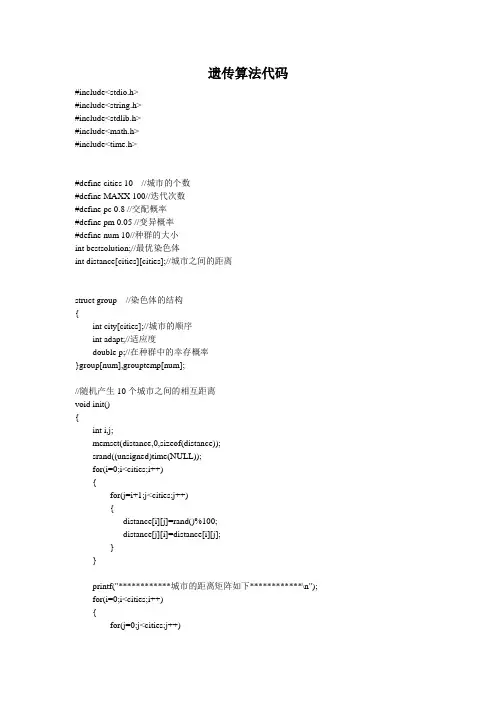

遗传算法经典学习Matlab代码遗传算法实例:也是自己找来的,原代码有少许错误,本人都已更正了,调试运行都通过了的。
对于初学者,尤其是还没有编程经验的非常有用的一个文件遗传算法实例% 下面举例说明遗传算法%% 求下列函数的最大值%% f(x)=10*sin(5x)+7*cos(4x) x∈[0,10]%% 将x 的值用一个10位的二值形式表示为二值问题,一个10位的二值数提供的分辨率是每为(10-0)/(2^10-1)≈0.01。
%% 将变量域[0,10] 离散化为二值域[0,1023], x=0+10*b/1023, 其中 b 是[0,1023] 中的一个二值数。
%% %%--------------------------------------------------------------------------------------------------------------%%--------------------------------------------------------------------------------------------------------------%% 编程%-----------------------------------------------% 2.1初始化(编码)% initpop.m函数的功能是实现群体的初始化,popsize表示群体的大小,chromlength表示染色体的长度(二值数的长度),% 长度大小取决于变量的二进制编码的长度(在本例中取10位)。
%遗传算法子程序%Name: initpop.m%初始化function pop=initpop(popsize,chromlength)pop=round(rand(popsize,chromlength)); % rand随机产生每个单元为{0,1} 行数为popsize,列数为chromlength的矩阵,% roud对矩阵的每个单元进行圆整。
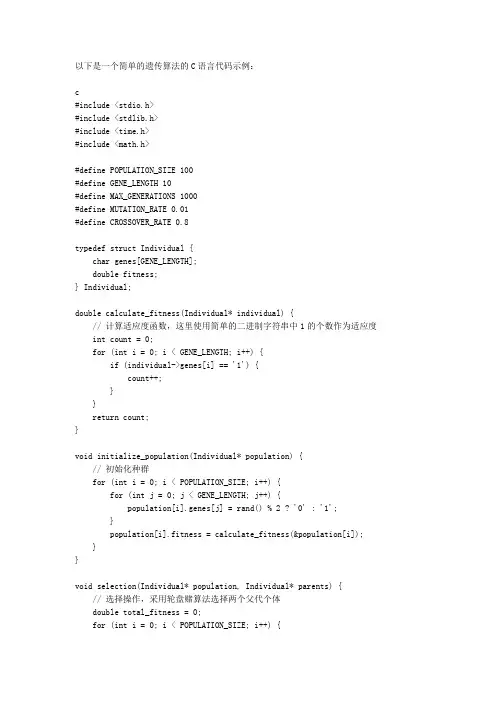
以下是一个简单的遗传算法的C语言代码示例:c#include <stdio.h>#include <stdlib.h>#include <time.h>#include <math.h>#define POPULATION_SIZE 100#define GENE_LENGTH 10#define MAX_GENERATIONS 1000#define MUTATION_RATE 0.01#define CROSSOVER_RATE 0.8typedef struct Individual {char genes[GENE_LENGTH];double fitness;} Individual;double calculate_fitness(Individual* individual) {// 计算适应度函数,这里使用简单的二进制字符串中1的个数作为适应度 int count = 0;for (int i = 0; i < GENE_LENGTH; i++) {if (individual->genes[i] == '1') {count++;}}return count;}void initialize_population(Individual* population) {// 初始化种群for (int i = 0; i < POPULATION_SIZE; i++) {for (int j = 0; j < GENE_LENGTH; j++) {population[i].genes[j] = rand() % 2 ? '0' : '1';}population[i].fitness = calculate_fitness(&population[i]); }}void selection(Individual* population, Individual* parents) {// 选择操作,采用轮盘赌算法选择两个父代个体double total_fitness = 0;for (int i = 0; i < POPULATION_SIZE; i++) {total_fitness += population[i].fitness;}double rand1 = rand() / (double)RAND_MAX * total_fitness;double rand2 = rand() / (double)RAND_MAX * total_fitness;double cumulative_fitness = 0;int parent1_index = -1, parent2_index = -1;for (int i = 0; i < POPULATION_SIZE; i++) {cumulative_fitness += population[i].fitness;if (rand1 < cumulative_fitness && parent1_index == -1) {parent1_index = i;}if (rand2 < cumulative_fitness && parent2_index == -1) {parent2_index = i;}}parents[0] = population[parent1_index];parents[1] = population[parent2_index];}void crossover(Individual* parents, Individual* offspring) {// 交叉操作,采用单点交叉算法生成两个子代个体int crossover_point = rand() % GENE_LENGTH;for (int i = 0; i < crossover_point; i++) {offspring[0].genes[i] = parents[0].genes[i];offspring[1].genes[i] = parents[1].genes[i];}for (int i = crossover_point; i < GENE_LENGTH; i++) {offspring[0].genes[i] = parents[1].genes[i];offspring[1].genes[i] = parents[0].genes[i];}offspring[0].fitness = calculate_fitness(&offspring[0]);offspring[1].fitness = calculate_fitness(&offspring[1]);}void mutation(Individual* individual) {// 变异操作,以一定概率翻转基因位上的值for (int i = 0; i < GENE_LENGTH; i++) {if (rand() / (double)RAND_MAX < MUTATION_RATE) {individual->genes[i] = individual->genes[i] == '0' ? '1' : '0'; }}individual->fitness = calculate_fitness(individual);}void replace(Individual* population, Individual* offspring) {// 替换操作,将两个子代个体中适应度更高的一个替换掉种群中适应度最低的一个个体int worst_index = -1;double worst_fitness = INFINITY;for (int i = 0; i < POPULATION_SIZE; i++) {if (population[i].fitness < worst_fitness) {worst_index = i;worst_fitness = population[i].fitness;}}if (offspring[0].fitness > worst_fitness || offspring[1].fitness > worst_fitness) {if (offspring[0].fitness > offspring[1].fitness) {population[worst_index] = offspring[0];} else {population[worst_index] = offspring[1];}}}。
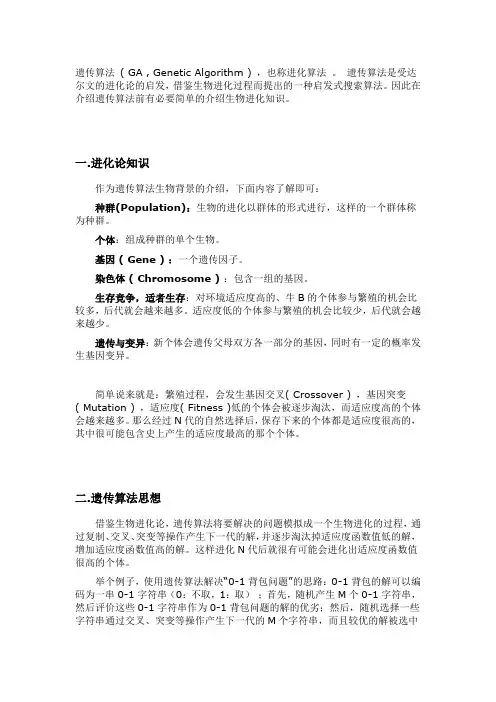
遗传算法( GA , Genetic Algorithm ) ,也称进化算法。
遗传算法是受达尔文的进化论的启发,借鉴生物进化过程而提出的一种启发式搜索算法。
因此在介绍遗传算法前有必要简单的介绍生物进化知识。
一.进化论知识作为遗传算法生物背景的介绍,下面内容了解即可:种群(Population):生物的进化以群体的形式进行,这样的一个群体称为种群。
个体:组成种群的单个生物。
基因 ( Gene ) :一个遗传因子。
染色体 ( Chromosome ):包含一组的基因。
生存竞争,适者生存:对环境适应度高的、牛B的个体参与繁殖的机会比较多,后代就会越来越多。
适应度低的个体参与繁殖的机会比较少,后代就会越来越少。
遗传与变异:新个体会遗传父母双方各一部分的基因,同时有一定的概率发生基因变异。
简单说来就是:繁殖过程,会发生基因交叉( Crossover ) ,基因突变( Mutation ) ,适应度( Fitness )低的个体会被逐步淘汰,而适应度高的个体会越来越多。
那么经过N代的自然选择后,保存下来的个体都是适应度很高的,其中很可能包含史上产生的适应度最高的那个个体。
二.遗传算法思想借鉴生物进化论,遗传算法将要解决的问题模拟成一个生物进化的过程,通过复制、交叉、突变等操作产生下一代的解,并逐步淘汰掉适应度函数值低的解,增加适应度函数值高的解。
这样进化N代后就很有可能会进化出适应度函数值很高的个体。
举个例子,使用遗传算法解决“0-1背包问题”的思路:0-1背包的解可以编码为一串0-1字符串(0:不取,1:取);首先,随机产生M个0-1字符串,然后评价这些0-1字符串作为0-1背包问题的解的优劣;然后,随机选择一些字符串通过交叉、突变等操作产生下一代的M个字符串,而且较优的解被选中的概率要比较高。
这样经过G代的进化后就可能会产生出0-1背包问题的一个“近似最优解”。
编码:需要将问题的解编码成字符串的形式才能使用遗传算法。
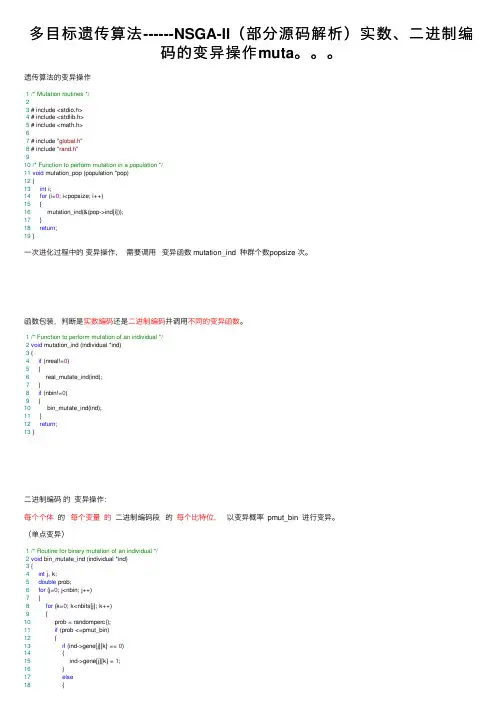
多⽬标遗传算法------NSGA-II(部分源码解析)实数、⼆进制编码的变异操作muta。
遗传算法的变异操作1/* Mutation routines */23 # include <stdio.h>4 # include <stdlib.h>5 # include <math.h>67 # include "global.h"8 # include "rand.h"910/* Function to perform mutation in a population */11void mutation_pop (population *pop)12 {13int i;14for (i=0; i<popsize; i++)15 {16 mutation_ind(&(pop->ind[i]));17 }18return;19 }⼀次进化过程中的变异操作,需要调⽤变异函数 mutation_ind 种群个数popsize 次。
函数包装,判断是实数编码还是⼆进制编码并调⽤不同的变异函数。
1/* Function to perform mutation of an individual */2void mutation_ind (individual *ind)3 {4if (nreal!=0)5 {6 real_mutate_ind(ind);7 }8if (nbin!=0)9 {10 bin_mutate_ind(ind);11 }12return;13 }⼆进制编码的变异操作:每个个体的每个变量的⼆进制编码段的每个⽐特位,以变异概率 pmut_bin 进⾏变异。
(单点变异)1/* Routine for binary mutation of an individual */2void bin_mutate_ind (individual *ind)3 {4int j, k;5double prob;6for (j=0; j<nbin; j++)7 {8for (k=0; k<nbits[j]; k++)9 {10 prob = randomperc();11if (prob <=pmut_bin)12 {13if (ind->gene[j][k] == 0)14 {15 ind->gene[j][k] = 1;16 }17else18 {19 ind->gene[j][k] = 0;20 }21 nbinmut+=1;22 }23 }24 }25return;26 }实数编码情况下的变异操作:(多项式变异)1/* Routine for real polynomial mutation of an individual */2void real_mutate_ind (individual *ind)3 {4int j;5double rnd, delta1, delta2, mut_pow, deltaq;6double delta;7double y, yl, yu, val, xy;8for (j=0; j<nreal; j++)9 {10 rnd = randomperc();11if (rnd <= pmut_real)12 {13 y = ind->xreal[j];14 yl = min_realvar[j];15 yu = max_realvar[j];16 delta1 = (y-yl)/(yu-yl);17 delta2 = (yu-y)/(yu-yl);18 delta = minimum (delta1,delta2);19 rnd = randomperc();20 mut_pow = 1.0/(eta_m+1.0);21if (rnd <= 0.5)22 {23 xy = 1.0-delta1;24 val = 2.0*rnd+(1.0-2.0*rnd)*(pow(xy,(eta_m+1.0)));25 deltaq = pow(val,mut_pow) - 1.0;26 }27else28 {29 xy = 1.0-delta2;30 val = 2.0*(1.0-rnd)+2.0*(rnd-0.5)*(pow(xy,(eta_m+1.0)));31 deltaq = 1.0 - (pow(val,mut_pow));32 }33 y = y + deltaq*(yu-yl);34if (y<yl)35 {36 y = yl;37 }38if (y>yu)39 {40 y = yu;41 }42 ind->xreal[j] = y;43 nrealmut+=1;44 }45 }46return;47 }eta_m 为实数编码的多项式变异的参数,为全局设定。
python遗传算法实数编码遗传算法是一种基于生物进化理论的智能优化算法。
它通过不断迭代,通过“进化”过程中的遗传变异、交叉和选择筛选,获取到最优的解集。
实数编码是遗传算法中常用的编码方式之一,它的基本思想是将优化问题中的实数参数转换成染色体中的基因,从而对这些实数参数进行优化。
在实数编码实现遗传算法时,需要结合实际问题给出适应度函数、交叉概率、变异概率等参数。
本文将基于Python语言,介绍实数编码遗传算法的实现过程。
一、实数编码实数编码是一种将实数参数转化为遗传算法所需的二进制基因串的方法。
以单变量问题为例,假设参数x∈[a,b],可以将x分为n个离散的点,如上图所示。
然后我们可以将这n个点转换成一组二进制串,从而实现实数编码。
假设精度为2的n次方,即每个二进制位表示的数值为(b-a)/(2^(n)-1),则可以根据以下公式将原始实数x转换成二进制串c:c=(x−a)/(b−a)×(2^n−1)例如,当n=8时,假设a=0,b=10,对于x=7,我们可以得到c=11100110。
二、适应度函数在实数编码的遗传算法中,需要将问题的优化目标转化为适应度函数。
适应度函数的设计是整个优化过程中最为重要的一环。
一般来说,适应度函数应该与实际问题有密切的联系,随着迭代次数的增加,适应度值应该越来越优。
在实数编码的遗传算法中,适应度函数一般可以定义为:f(x)=1/(1+g(x))其中,x表示变量的取值,g(x)表示问题的目标函数(即需要优化的函数)。
适应度函数f(x)的值应当为正值,使得适应度值越大的个体有更高的概率被选中进入下一代。
一般而言,适应度函数的计算需要根据具体问题的要求来进行设计。
三、交叉和变异交叉和变异是实数编码遗传算法的核心操作。
在交叉操作中,我们需要选择两个个体,并确定交叉点。
交叉点之前的基因串被交换生成新的个体。
在变异操作中,我们随机设定一个基因位,并将其改变成随机的一个值。
如何选择和设计遗传算法的编码方式遗传算法是一种模拟生物进化过程的优化算法,广泛应用于解决复杂问题。
在遗传算法中,编码方式是决定问题表示和求解效果的关键因素之一。
选择和设计合适的编码方式对于算法的性能和效果具有重要影响。
本文将从选择和设计两个方面探讨如何选择和设计遗传算法的编码方式。
一、选择编码方式选择合适的编码方式是遗传算法的基础,决定了问题的表示和求解效果。
常见的编码方式有二进制编码、整数编码、实数编码和排列编码等。
1. 二进制编码二进制编码是最常用的编码方式之一,适用于表示离散问题。
例如,对于旅行商问题,可以用二进制编码表示每个城市的访问顺序。
二进制编码简单、易于实现和操作,但对于连续问题不太适用。
2. 整数编码整数编码适用于表示整数型问题。
例如,对于任务调度问题,可以用整数编码表示每个任务的执行顺序。
整数编码相对于二进制编码更加直观,但在某些情况下可能会导致解空间的过大。
3. 实数编码实数编码适用于表示连续问题。
例如,对于函数优化问题,可以用实数编码表示函数的参数。
实数编码可以更精确地表示问题的解,但在操作和交叉过程中需要考虑浮点数的精度问题。
4. 排列编码排列编码适用于表示排列问题。
例如,对于旅行商问题,可以用排列编码表示城市的访问顺序。
排列编码能够保持问题的结构特性,但在操作和交叉过程中需要考虑排列的合法性。
选择编码方式时需要根据具体问题的性质和要求进行综合考虑。
对于离散问题,二进制编码和整数编码通常是较好的选择;对于连续问题,实数编码更适合;对于排列问题,排列编码是更合适的选择。
二、设计编码方式设计合适的编码方式可以进一步提高遗传算法的性能和效果。
在设计编码方式时,需要考虑问题的特点和约束条件。
1. 编码长度编码长度是指编码的位数或数组长度。
编码长度的选择需要考虑问题的复杂程度和解的表示范围。
编码长度过短可能导致解空间的过小,难以找到最优解;编码长度过长可能导致搜索空间的过大,增加计算复杂度。
遗传算法Matlab源代码完整可以运行的数值优化遗传算法源代码function[X,MaxFval,BestPop,Trace]=fga(FUN,bounds,MaxEranum,PopSiz e,options,pCross,pMutation,pInversion)%[X,MaxFval,BestPop,Trace]=fga(FUN,bounds,MaxEranum,PopSiz e,options,pCross,pMutation,pInversion)% Finds a maximum of a function of several variables.% fga solves problems of the form:% max F(X) subject to: LB = X = UB (LB=bounds(:,1),UB=bounds(:,2))% X - 最优个体对应自变量值% MaxFval - 最优个体对应函数值% BestPop - 最优的群体即为最优的染色体群% Trace - 每代最佳个体所对应的目标函数值% FUN - 目标函数% bounds - 自变量范围% MaxEranum - 种群的代数,取50--500(默认200)% PopSize - 每一代种群的规模;此可取50--200(默认100)% pCross - 交叉概率,一般取0.5--0.85之间较好(默认0.8)% pMutation - 初始变异概率,一般取0.05-0.2之间较好(默认0.1)% pInversion - 倒位概率,一般取0.05-0.3之间较好(默认0.2) % options - 1*2矩阵,options(1)=0二进制编码(默认0),option(1)~=0十进制编码,option(2)设定求解精度(默认1e-4)T1=clock;%检验初始参数if nargin2, error('FMAXGA requires at least three input arguments'); endif nargin==2, MaxEranum=150;PopSize=100;options=[1 1e-4];pCross=0.85;pMutation=0.1;pInversion=0.25;endif nargin==3, PopSize=100;options=[1 1e-4];pCross=0.85;pMutation=0.1;pInversion=0.25;endif nargin==4, options=[1 1e-4];pCross=0.85;pMutation=0.1;pInversion=0.25;endif nargin==5, pCross=0.85;pMutation=0.1;pInversion=0.25;endif nargin==6, pMutation=0.1;pInversion=0.25;endif nargin==7, pInversion=0.25;endif (options(1)==0|options(1)==1)find((bounds(:,1)-bounds(:,2))0)error('数据输入错误,请重新输入:');end% 定义全局变量global m n NewPop children1 children2 VarNum% 初始化种群和变量precision = options(2);bits = ceil(log2((bounds(:,2)-bounds(:,1))' ./ precision));%由设定精度划分区间VarNum = size(bounds,1);[Pop] = InitPop(PopSize,bounds,bits,options);%初始化种群[m,n] = size(Pop);fit = zeros(1,m);NewPop = zeros(m,n);children1 = zeros(1,n);children2 = zeros(1,n);pm0 = pMutation;BestPop = zeros(MaxEranum,n);%分配初始解空间BestPop,TraceTrace = zeros(1,MaxEranum);完整可以运行的数值优化遗传算法源代码Lb = ones(PopSize,1)*bounds(:,1)';Ub = ones(PopSize,1)*bounds(:,2)';%二进制编码采用多点交叉和均匀交叉,并逐步增大均匀交叉概率%浮点编码采用离散交叉(前期)、算术交叉(中期)、AEA重组(后期)OptsCrossOver = [ones(1,MaxEranum)*options(1);...round(unidrnd(2*(MaxEranum-[1:MaxEranum]))/MaxEranum)]';%浮点编码时采用两种自适应变异和一种随机变异(自适应变异发生概率为随机变异发生的2倍)OptsMutation = [ones(1,MaxEranum)*options(1);unidrnd(5,1,MaxEranum)]';if options(1)==3D=zeros(n);CityPosition=bounds;D = sqrt((CityPosition(:, ones(1,n)) - CityPosition(:, ones(1,n))').^2 +...(CityPosition(:,2*ones(1,n)) - CityPosition(:,2*ones(1,n))').^2 );end%========================================================================== % 进化主程序%%===================================== ===================================== eranum = 1;H=waitbar(0,'Please wait...');while(eranum=MaxEranum)for j=1:mif options(1)==1%eval(['[fit(j)]=' FUN '(Pop(j,:));']);%但执行字符串速度比直接计算函数值慢fit(j)=feval(FUN,Pop(j,:));%计算适应度elseif options(1)==0%eval(['[fit(j)]=' FUN '(b2f(Pop(j,:),bounds,bits));']);fit(j)=feval(FUN,(b2f(Pop(j,:),bounds,bits)));elsefit(j)=-feval(FUN,Pop(j,:),D);endend[Maxfit,fitIn]=max(fit);%得到每一代最大适应值Meanfit(eranum)=mean(fit);BestPop(eranum,:)=Pop(fitIn,:);Trace(eranum)=Maxfit;if options(1)==1Pop=(Pop-Lb)./(Ub-Lb);%将定义域映射到[0,1]:[Lb,Ub]--[0,1] ,Pop--(Pop-Lb)./(Ub-Lb)endswitch round(unifrnd(0,eranum/MaxEranum))%进化前期尽量使用实行锦标赛选择,后期逐步增大非线性排名选择case {0} [selectpop]=TournamentSelect(Pop,fit,bits);%锦标赛选择case {1}[selectpop]=NonlinearRankSelect(Pop,fit,bits);%非线性排名选择end完整可以运行的数值优化遗传算法源代码[CrossOverPop]=CrossOver(selectpop,pCross,OptsCrossOver(er anum,:));%交叉[MutationPop]=Mutation(CrossOverPop,fit,pMutation,VarNum,O ptsMutation(eranum,:)); %变异[InversionPop]=Inversion(MutationPop,pInversion);%倒位%更新种群if options(1)==1Pop=Lb+InversionPop.*(Ub-Lb);%还原PopelsePop=InversionPop;endpMutation=pm0+(eranum^3)*(pCross/2-pm0)/(eranum^4); %逐步增大变异率至1/2交叉率percent=num2str(round(100*eranum/MaxEranum));waitbar(eranum/MaxEranum,H,['Evolution complete ',percent,'%']);eranum=eranum+1;endclose(H);% 格式化输出进化结果和解的变化情况t=1:MaxEranum;plot(t,Trace,t,Meanfit);legend('解的变化','种群的变化');title('函数优化的遗传算法');xlabel('进化世代数');ylabel('每一代最优适应度');[MaxFval,MaxFvalIn]=max(Trace);if options(1)==1|options(1)==3X=BestPop(MaxFvalIn,:);elseif options(1)==0X=b2f(BestPop(MaxFvalIn,:),bounds,bits);endhold on;plot(MaxFvalIn,MaxFval,'*');text(MaxFvalIn+5,MaxFval,['FMAX=' num2str(MaxFval)]);str1=sprintf(' Best generation:\n %d\n\n Best X:\n %s\n\n MaxFval\n %f\n',...MaxFvalIn,num2str(X),MaxFval);disp(str1);% -计时T2=clock;elapsed_time=T2-T1;if elapsed_time(6)0elapsed_time(6)=elapsed_time(6)+60;elapsed_time(5)=elapsed_time(5)-1;endif elapsed_time(5)0elapsed_time(5)=elapsed_time(5)+60;elapsed_time(4)=elapsed_t ime(4)-1;end完整可以运行的数值优化遗传算法源代码str2=sprintf('elapsed_time\n %d (h) %d (m) %.4f (s)',elapsed_time(4),elapsed_time(5),elapsed_time(6));disp(str2);%===================================== ===================================== % 遗传操作子程序%%===================================== ===================================== % -- 初始化种群--% 采用浮点编码和二进制Gray编码(为了克服二进制编码的Hamming悬崖缺点)function [initpop]=InitPop(popsize,bounds,bits,options)numVars=size(bounds,1);%变量数目rang=(bounds(:,2)-bounds(:,1))';%变量范围if options(1)==1initpop=zeros(popsize,numVars);initpop=(ones(popsize,1)*rang).*(rand(popsize,numVars))+(ones (popsize,1)*bounds(:,1)');elseif options(1)==0precision=options(2);%由求解精度确定二进制编码长度len=sum(bits);initpop=zeros(popsize,len);%The whole zero encoding individualfor i=2:popsize-1pop=round(rand(1,len));pop=mod(([0 pop]+[pop 0]),2);%i=1时,b(1)=a(1);i1时,b(i)=mod(a(i-1)+a(i),2)%其中原二进制串:a(1)a(2)...a(n),Gray串:b(1)b(2)...b(n)initpop(i,:)=pop(1:end-1);endinitpop(popsize,:)=ones(1,len);%The whole one encoding individualelsefor i=1:popsizeinitpop(i,:)=randperm(numVars);%为Tsp问题初始化种群endend% -- 二进制串解码--function [fval] = b2f(bval,bounds,bits)% fval - 表征各变量的十进制数% bval - 表征各变量的二进制编码串% bounds - 各变量的取值范围% bits - 各变量的二进制编码长度scale=(bounds(:,2)-bounds(:,1))'./(2.^bits-1); %The range of the variablesnumV=size(bounds,1);cs=[0 cumsum(bits)];for i=1:numVa=bval((cs(i)+1):cs(i+1));fval(i)=sum(2.^(size(a,2)-1:-1:0).*a)*scale(i)+bounds(i,1);end% -- 选择操作--完整可以运行的数值优化遗传算法源代码% 采用基于轮盘赌法的非线性排名选择% 各个体成员按适应值从大到小分配选择概率:% P(i)=(q/1-(1-q)^n)*(1-q)^i, 其中P(0)P(1)...P(n), sum(P(i))=1function [NewPop]=NonlinearRankSelect(OldPop,fit,bits) global m n NewPopfit=fit';selectprob=fit/sum(fit);%计算各个体相对适应度(0,1)q=max(selectprob);%选择最优的概率x=zeros(m,2);x(:,1)=[m:-1:1]';[y x(:,2)]=sort(selectprob);r=q/(1-(1-q)^m);%标准分布基值newfit(x(:,2))=r*(1-q).^(x(:,1)-1);%生成选择概率newfit=[0 cumsum(newfit)];%计算各选择概率之和rNums=rand(m,1);newIn=1;while(newIn=m)NewPop(newIn,:)=OldPop(length(find(rNums(newIn)newfit)),:);newIn=newIn+1;end% -- 锦标赛选择(含精英选择) --function [NewPop]=TournamentSelect(OldPop,fit,bits)global m n NewPopnum=floor(m./2.^(1:10));num(find(num==0))=[];L=length(num);a=sum(num);b=m-a;PopIn=1;while(PopIn=L)r=unidrnd(m,num(PopIn),2^PopIn);[LocalMaxfit,In]=max(fit(r),[],2);SelectIn=r((In-1)*num(PopIn)+[1:num(PopIn)]');NewPop(sum(num(1:PopIn))-num(PopIn)+1:sum(num(1:PopIn)),:)=OldPop(SelectIn,:);PopIn=PopIn+1;r=[];In=[];LocalMaxfit=[];endif b1NewPop((sum(num)+1):(sum(num)+b-1),:)=OldPop(unidrnd(m,1,b-1),:);end[GlobalMaxfit,I]=max(fit);%保留每一代中最佳个体NewPop(end,:)=OldPop(I,:);% -- 交叉操作--function [NewPop]=CrossOver(OldPop,pCross,opts)global m n NewPopr=rand(1,m);完整可以运行的数值优化遗传算法源代码y1=find(rpCross);y2=find(r=pCross);len=length(y1);if len==1|(len2mod(len,2)==1)%如果用来进行交叉的染色体的条数为奇数,将其调整为偶数y2(length(y2)+1)=y1(len);y1(len)=[];endi=0;if length(y1)=2if opts(1)==1%浮点编码交叉while(i=length(y1)-2)NewPop(y1(i+1),:)=OldPop(y1(i+1),:);NewPop(y1(i+2),:)=OldPop(y1(i+2),:);if opts(2)==0n1%discret crossoverPoints=sort(unidrnd(n,1,2));NewPop(y1(i+1),Points(1):Points(2))=OldPop(y1(i+2),Points(1):Po ints(2));NewPop(y1(i+2),Points(1):Points(2))=OldPop(y1(i+1),Points(1):Po ints(2));elseif opts(2)==1%arithmetical crossoverPoints=round(unifrnd(0,pCross,1,n));CrossPoints=find(Points==1);r=rand(1,length(CrossPoints));NewPop(y1(i+1),CrossPoints)=r.*OldPop(y1(i+1),CrossPoints)+(1 -r).*OldPop(y1(i+2),CrossPoints);NewPop(y1(i+2),CrossPoints)=r.*OldPop(y1(i+2),CrossPoints)+(1 -r).*OldPop(y1(i+1),CrossPoints); else %AEA recombination Points=round(unifrnd(0,pCross,1,n));CrossPoints=find(Points==1);v=unidrnd(4,1,2);NewPop(y1(i+1),CrossPoints)=(floor(10^v(1)*OldPop(y1(i+1),Cro ssPoints))+...10^v(1)*OldPop(y1(i+2),CrossPoints)-floor(10^v(1)*OldPop(y1(i+2),CrossPoints)))/10^v(1);NewPop(y1(i+2),CrossPoints)=(floor(10^v(2)*OldPop(y1(i+2),Cro ssPoints))+...10^v(2)*OldPop(y1(i+1),CrossPoints)-floor(10^v(2)*OldPop(y1(i+1),CrossPoints)))/10^v(2);endi=i+2;endelseif opts(1)==0%二进制编码交叉while(i=length(y1)-2)if opts(2)==0[NewPop(y1(i+1),:),NewPop(y1(i+2),:)]=EqualCrossOver(OldPop( y1(i+1),:),OldPop(y1(i+2),:)); else[NewPop(y1(i+1),:),NewPop(y1(i+2),:)]=MultiPointCross(OldPop( y1(i+1),:),OldPop(y1(i+2),:)); endi=i+2;endelse %Tsp问题次序杂交for i=0:2:length(y1)-2xPoints=sort(unidrnd(n,1,2));NewPop([y1(i+1)y1(i+2)],xPoints(1):xPoints(2))=OldPop([y1(i+2)y1(i+1)],xPoints(1):xPoints(2));完整可以运行的数值优化遗传算法源代码%NewPop(y1(i+2),xPoints(1):xPoints(2))=OldPop(y1(i+1),xPo ints(1):xPoints(2));temp=[OldPop(y1(i+1),xPoints(2)+1:n)OldPop(y1(i+1),1:xPoints(2))];for del1i=xPoints(1):xPoints(2)temp(find(temp==OldPop(y1(i+2),del1i)))=[];endNewPop(y1(i+1),(xPoints(2)+1):n)=temp(1:(n-xPoints(2)));NewPop(y1(i+1),1:(xPoints(1)-1))=temp((n-xPoints(2)+1):end);temp=[OldPop(y1(i+2),xPoints(2)+1:n)OldPop(y1(i+2),1:xPoints(2))];for del2i=xPoints(1):xPoints(2)temp(find(temp==OldPop(y1(i+1),del2i)))=[];endNewPop(y1(i+2),(xPoints(2)+1):n)=temp(1:(n-xPoints(2)));NewPop(y1(i+2),1:(xPoints(1)-1))=temp((n-xPoints(2)+1):end);endendendNewPop(y2,:)=OldPop(y2,:);% -二进制串均匀交叉算子function[children1,children2]=EqualCrossOver(parent1,parent2) global n children1 children2hidecode=round(rand(1,n));%随机生成掩码crossposition=find(hidecode==1);holdposition=find(hidecode==0);children1(crossposition)=parent1(crossposition);%掩码为1,父1为子1提供基因children1(holdposition)=parent2(holdposition);%掩码为0,父2为子1提供基因children2(crossposition)=parent2(crossposition);%掩码为1,父2为子2提供基因children2(holdposition)=parent1(holdposition);%掩码为0,父1为子2提供基因% -二进制串多点交叉算子function[Children1,Children2]=MultiPointCross(Parent1,Parent2)%交叉点数由变量数决定global n Children1 Children2 VarNumChildren1=Parent1;Children2=Parent2;Points=sort(unidrnd(n,1,2*VarNum));for i=1:VarNumChildren1(Points(2*i-1):Points(2*i))=Parent2(Points(2*i-1):Points(2*i));Children2(Points(2*i-1):Points(2*i))=Parent1(Points(2*i-1):Points(2*i));end% -- 变异操作--function[NewPop]=Mutation(OldPop,fit,pMutation,VarNum,opts) global m n NewPopNewPop=OldPop;r=rand(1,m);MutIn=find(r=pMutation);L=length(MutIn);完整可以运行的数值优化遗传算法源代码i=1;if opts(1)==1%浮点变异maxfit=max(fit);upfit=maxfit+0.05*abs(maxfit);if opts(2)==1|opts(2)==3while(i=L)%自适应变异(自增或自减)Point=unidrnd(n);T=(1-fit(MutIn(i))/upfit)^2;q=abs(1-rand^T);%if q1%按严格数学推理来说,这段程序是不能缺少的% q=1%endp=OldPop(MutIn(i),Point)*(1-q);if unidrnd(2)==1NewPop(MutIn(i),Point)=p+q;elseNewPop(MutIn(i),Point)=p;endi=i+1;endelseif opts(2)==2|opts(2)==4%AEA变异(任意变量的某一位变异)while(i=L)Point=unidrnd(n);T=(1-abs(upfit-fit(MutIn(i)))/upfit)^2;v=1+unidrnd(1+ceil(10*T));%v=1+unidrnd(5+ceil(10*eranum/MaxEranum));q=mod(floor(OldPop(MutIn(i),Point)*10^v),10);NewPop(MutIn(i),Point)=OldPop(MutIn(i),Point)-(q-unidrnd(9))/10^v;i=i+1;endelsewhile(i=L)Point=unidrnd(n);if round(rand)NewPop(MutIn(i),Point)=OldPop(MutIn(i),Point)*(1-rand);elseNewPop(MutIn(i),Point)=OldPop(MutIn(i),Point)+(1-OldPop(MutIn(i),Point))*rand; endi=i+1;endendelseif opts(1)==0%二进制串变异if L=1while i=Lk=unidrnd(n,1,VarNum); %设置变异点数(=变量数)for j=1:length(k)if NewPop(MutIn(i),k(j))==1NewPop(MutIn(i),k(j))=0;else完整可以运行的数值优化遗传算法源代码NewPop(MutIn(i),k(j))=1;endendi=i+1;endendelse%Tsp变异if opts(2)==1|opts(2)==2|opts(2)==3|opts(2)==4numMut=ceil(pMutation*m);r=unidrnd(m,numMut,2);[LocalMinfit,In]=min(fit(r),[],2);SelectIn=r((In-1)*numMut+[1:numMut]');while(i=numMut)mPoints=sort(unidrnd(n,1,2));if mPoints(1)~=mPoints(2)NewPop(SelectIn(i),1:mPoints(1)-1)=OldPop(SelectIn(i),1:mPoints(1)-1);NewPop(SelectIn(i),mPoints(1):mPoints(2)-1)=OldPop(SelectIn(i),mPoints(1)+1:mPoints(2));NewPop(SelectIn(i),mPoints(2))=OldPop(SelectIn(i),mPoints(1));NewPop(SelectIn(i),mPoints(2)+1:n)=OldPop(SelectIn(i),mPoints( 2)+1:n);elseNewPop(SelectIn(i),:)=OldPop(SelectIn(i),:);endi=i+1;endr=rand(1,m);MutIn=find(r=pMutation);L=length(MutIn);while i=LmPoints=sort(unidrnd(n,1,2));rIn=randperm(mPoints(2)-mPoints(1)+1);NewPop(MutIn(i),mPoints(1):mPoints(2))=OldPop(MutIn(i),mPoin ts(1)+rIn-1);i=i+1;endendend% -- 倒位操作--function [NewPop]=Inversion(OldPop,pInversion)global m n NewPopNewPop=OldPop;r=rand(1,m);PopIn=find(r=pInversion);len=length(PopIn);if len=1while(i=len)d=sort(unidrnd(n,1,2));完整可以运行的数值优化遗传算法源代码NewPop(PopIn(i),d(1):d(2))=OldPop(PopIn(i),d(2):-1:d(1)); i=i+1;。
基于实数编码(离散杂交+⾃适应变异),线性排名选择的遗传算法(附代码)版权声明:本⽂为博主原创⽂章,转载请注明出处。
我们来看⼀个很简单的⼩问题f=x1+x2+x3+x4,x1、x2、x3、x4是⼤于等于10⼩于等于100的实数,求f的最⼤值。
这个⼩学⽣就能解决的问题我今天打算⽤遗传算法来解决,你可能说这不是智障吗?但是其实这只是⼀个⼩例⼦,因为⽤同样的⽅法,你可以解决f=x1^x2*x3^x4/x2^x1*x4^x3甚⾄是更复杂的问题,下⾯就来详细讲⼀讲。
基于对遗传算法的⼀般性了解,我就不再赘述详细过程(其实是因为上⼀篇写过了懒得再写⼀遍),只谈谈实数编码和线性排名选择策略。
实数编码顾名思义就是⽤实数进⾏编码,实数来做染⾊体的基因,实数构成染⾊体,他的本质其实是⽤问题的⼀个解空间来做⼀个染⾊体,⽐如{20.5658.15.2385,89.0000,56.4400},就是上⾯⼩问题的⼀个解空间,就可以把它作为⼀个染⾊体⽤于进化,其中的每⼀个x1,x2都是⼀个基因,那些交叉,变异都是基于这样的设定的。
在这⾥插⼀句,实数编码和整数编码的思想是极为类似的,但是实数编码的解空间更⼤更复杂。
现在来讲讲实数编码的交叉和变异1、交叉实数编码的杂交⽅式有离散杂交,算数杂交等等,本例只讲解离散杂交。
离散杂交和⼆进制的杂交是⼗分类似的,(可以)选定⼀个基因位,然后将选定的两个染⾊体在这个位置之后的基因进⾏交换(注意基因的定义区间是不变的)。
注意,在实数编码中,交叉的作⽤不是很⼤。
2、变异实数编码的变异包括均匀性变异、正态性变异、⾮⼀致性变异、⾃适应变异、多级变异等,本例只讲解⾃适应变异和⾮⼀致性变异。
(1)⾮⼀致性变异在传统的遗传算法中,突变的情况是与代数⽆关的。
但是进化刚开始时,就是需要向各个⽅向⼤步发展进⾏尝试,进化到了后期,解已经相对较优了,进⾏局部搜索可能更有利于找到更好的解。
显然传统的⽅法是不⾏的,必须找到⼀种将变异幅度和代数相联系的策略。
遗传算法的编码与解码
遗传算法的编码方式有多种,常见的有以下两种:
1. 二进制编码:将待优化问题的解编码成一串二进制字符串,例如:1010011010。
这种编码方式相对简单,但需要确定变量的编码长度和取值范围,同时会出现编码长度不够导致精度不高的问题。
2. 实数编码:将待优化过程的解编码成实数形式,例如:
0.234, 10.5。
这种编码方式比二进制编码更灵活,但需要确定变量取值范围和精度等参数。
解码是将编码后的结果转换为实际可用的值的过程。
对于二进制编码,解码方式可根据编码规则进行简单的转换;对于实数编码,解码方式需进行数值计算和转换。
解码后的值可用于评价适应度并进行进一步的遗传操作。
遗传算法解释及代码(一看就懂)遗传算法( GA , Genetic Algorithm ) ,也称进化算法。
遗传算法是受达尔文的进化论的启发,借鉴生物进化过程而提出的一种启发式搜索算法。
因此在介绍遗传算法前有必要简单的介绍生物进化知识。
一.进化论知识作为遗传算法生物背景的介绍,下面内容了解即可:种群(Population):生物的进化以群体的形式进行,这样的一个群体称为种群。
个体:组成种群的单个生物。
基因 ( Gene ) :一个遗传因子。
染色体 ( Chromosome ):包含一组的基因。
生存竞争,适者生存:对环境适应度高的、牛B的个体参与繁殖的机会比较多,后代就会越来越多。
适应度低的个体参与繁殖的机会比较少,后代就会越来越少。
遗传与变异:新个体会遗传父母双方各一部分的基因,同时有一定的概率发生基因变异。
简单说来就是:繁殖过程,会发生基因交叉( Crossover ) ,基因突变( Mutation ) ,适应度( Fitness )低的个体会被逐步淘汰,而适应度高的个体会越来越多。
那么经过N代的自然选择后,保存下来的个体都是适应度很高的,其中很可能包含史上产生的适应度最高的那个个体。
二.遗传算法思想借鉴生物进化论,遗传算法将要解决的问题模拟成一个生物进化的过程,通过复制、交叉、突变等操作产生下一代的解,并逐步淘汰掉适应度函数值低的解,增加适应度函数值高的解。
这样进化N代后就很有可能会进化出适应度函数值很高的个体。
举个例子,使用遗传算法解决“0-1背包问题”的思路:0-1背包的解可以编码为一串0-1字符串(0:不取,1:取);首先,随机产生M个0-1字符串,然后评价这些0-1字符串作为0-1背包问题的解的优劣;然后,随机选择一些字符串通过交叉、突变等操作产生下一代的M个字符串,而且较优的解被选中的概率要比较高。
这样经过G代的进化后就可能会产生出0-1背包问题的一个“近似最优解”。
编码:需要将问题的解编码成字符串的形式才能使用遗传算法。
function GA_real_coded_min
% ±¾ÀýΪʵÊý±àÂëÒÅ´«Ëã·¨Çóº¯Êý×îСֵµÄÓÅ»¯ÎÊÌâ
% Ä¿±êº¯ÊýΪ J = x1^2 + x2^2
% ÆäÖÐ x1 µÄ·¶Î§Îª [-10,10], x2 µÄ·¶Î§Îª [-10,10]
Size = 200;% the value of population
CodeL = 2;
MinX(1) = -10;
MaxX(1) = 10;
MinX(2) = -10;
MaxX(2) = 10;
E(:,1) = MinX(1) + (MaxX(1)-MinX(1))*rand(Size,1);
E(:,2) = MinX(2) + (MaxX(2)-MinX(2))*rand(Size,1);
G = 100;% the max generation
%---------------Start
Running---------------------------------------------
for kg = 1 : G
time(kg) = kg;
%----------------------step 1: Evaluate BestJ-------------------------for i = 1 : Size
xi = E(i,:);
x1 = xi(1);
x2 = xi(2);
% ÏÂÃæµÄ F
ÓÃÓÚ¼ÆËã¸öÌåµÄÊÊÓ¦¶ÈÖµ£¬ÊÊÓ¦¶Èº¯Êý¸ù¾ÝÄ¿±êº¯Êý½øÐÐÁËÏßÐԱ任
F(i) = 1/(x1^2 + x2^2);% ¼ÆËãÊÊÓ¦¶ÈÖµ£¬Ô½´óÔ½ºÃ
Ji = x1^2 + x2^2;% ¼ÆËãÄ¿±êÖµ£¬Ô½Ð¡Ô½ºÃ
BsJi(i) = min(Ji);
end
[OrderJi,IndexJi] = sort(BsJi);
BestJ(kg) = OrderJi(1);
Ji = BsJi + eps;% Avoiding deviding zero
fi = F;
[Orderfi,Indexfi] = sort(fi); % Arranging fi small to bigger
Bestfi = Orderfi(Size); % Let Bestfi=max(fi)
BestS = E(Indexfi(Size),:); % Let BestS=E(m),m is the Indexfi belongs to max(fi)
bfi(kg) = Bestfi;
kg
BestS
%--------------------Step 2:Select and Reproduct Operation------------ fi_sum = sum(fi);
fi_Size = (Orderfi/fi_sum)*Size;
fi_S = floor(fi_Size); % Selecting Bigger fi value
r = Size - sum(fi_S);
Rest = fi_Size - fi_S;
[RestValue,Index] = sort(Rest);
for i = Size : -1 : Size-r+1
fi_S(Index(i)) = fi_S(Index(i)) + 1;% Adding rest to equal Size end
k = 1;
for i = Size : -1 : 1
for j = 1 : fi_S(i)
TempE(k,:) = E(Indexfi(i),:); % Selecting and Reproduce
k = k + 1; % k is used to reproduce end
end
%---------------------Step 3: Crossover Operation--------------------- Pc = 0.90;
for i = 1 : 2 : Size-1
temp = rand;
if Pc > temp
alfa = rand;
TempE(i,:) = alfa*E(i+1,:) + (1-alfa)*E(i,:);
TempE(i+1,:) = alfa*E(i,:) + (1-alfa)*E(i+1,:);
end
end
TempE(Size,:) = BestS;
E = TempE;
%---------------------Step 4: Mutation Operation---------------------- Pm = 0.10 - [1:Size]*(0.01)/Size; % Bigger fi,smaller Pm
Pm_rand = rand(Size,CodeL);
Mean = (MaxX+MinX)/2;
Dif = MaxX - MinX;
for i = 1 : Size
for j = 1 : CodeL
if Pm(i) > Pm_rand(i,j);
TempE(i,j) = Mean(j) + Dif(j)*(rand-0.5);
end
end
end
% Guarantee TempE(Size,:) belong to the best individual
TempE(Size,:) = BestS;
E = TempE;
end
%-------------------------------------------------------------------------
BestS
Bestfi
figure(1);
plot(time,BestJ,'b');
xlabel('Generations'); ylabel('Best Objective');% the value of objective figure(2);
plot(time,bfi,'b');
xlabel('Generations'); ylabel('Best Fitness');% the value of fitness。